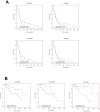A miRNA signature for defining aggressive phenotype and prognosis in gliomas
- PMID: 25279461
- PMCID: PMC4184816
- DOI: 10.1371/journal.pone.0108950
A miRNA signature for defining aggressive phenotype and prognosis in gliomas
Abstract
Gliomas represent a disparate group of tumours for which there are to date no cure. Thus, there is a recognized need for new diagnostic and therapeutic approaches based on increased understanding of their molecular nature. We performed the comparison of the microRNA (miRNA) profile of 8 WHO grade II gliomas and 24 higher grade tumours (2 WHO grade III and 22 glioblastomas) by using the Affymetrix GeneChip miRNA Array v. 1.0. A relative quantification method (RT-qPCR) with standard curve was used to confirm the 22 miRNA signature resulted by array analysis. The prognostic performances of the confirmed miRNAs were estimated on the Tumor Cancer Genome Atlas (TCGA) datasets. We identified 22 miRNAs distinguishing grade II gliomas from higher grade tumours. RT-qPCR confirmed the differential expression in the two patients' groups for 13 out of the 22 miRNAs. The analysis of the Glioblastoma Multiforme (GBM) and Lower Grade Glioma (LGG) datasets from TCGA demonstrated the association with prognosis for 6 of those miRNAs. Moreover, in the GBM dataset miR-21 and miR-210 were predictors of worse prognosis in both univariable and multivariable Cox regression analyses (HR 1.19, p = 0.04, and HR 1.18, p = 0.029 respectively). Our results support a direct contribution of miRNAs to glioma cancerogenesis and suggest that miR-21 and miR-210 may play a role in the aggressive clinical behaviour of glioblastomas.
Conflict of interest statement
Figures



References
-
- Galasso M, Sandhu SK, Volinia S (2012) MicroRNA expression signatures in solid malignancies. Cancer J 18: 238–243. - PubMed
Publication types
MeSH terms
Substances
LinkOut - more resources
Full Text Sources
Other Literature Sources
Medical
Molecular Biology Databases

